
Thesis
Thesis Document
Hey, no sense keeping this hidden on my hard drive. And until we get a full and working archive of all the thesis documents back at the department, this seems like the most logical place for it to go. Plus it will allow me to link it into CiteseerX, which I'm currently doing research with and loving. While I'm thinking about it, I"m also loving JabRef, the open-source citation manager. Just wish I'd discovered these last year.
- Mike's blog
- Comments
- Read more



- 4988 reads
Text Editors and Electric Kettles
I just read a great article on interfaces by Baobab's Mike McKay entitled Text Editors and Electric Kettles. It's really worth a read. It's the kind of thing I'd show to design students, it's so good. And it also does a nice job summing up some of the challenges and solutions that they're working with specifically down in Malawi. And, hey, if you have a digg account, bump the story up!
- Mike's blog
- Comments



- 4783 reads
Hospital Observations
Today's observations in pictures:
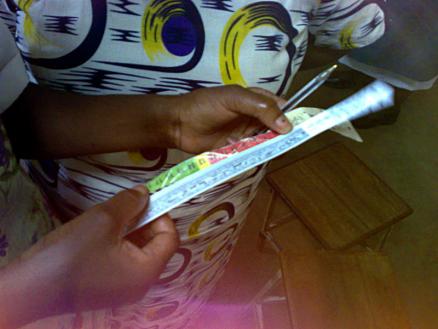 Battle of the Bands: Nurses in Kamuzu Central Hospital's Children's Ward C, which is dedicated to therapeutic nutrition, compare the UNICEF-style MUAC band with the prototype we've created.
Battle of the Bands: Nurses in Kamuzu Central Hospital's Children's Ward C, which is dedicated to therapeutic nutrition, compare the UNICEF-style MUAC band with the prototype we've created.
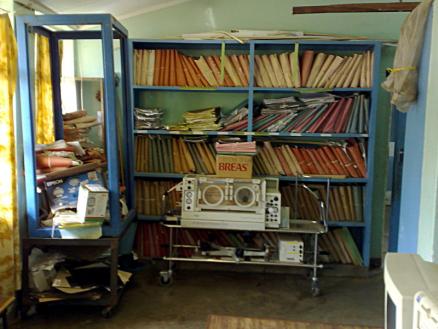 Paper Records: One of the driving forces behind implementing Baobab's patient-manage system in hospitals is to help reduce the problems associated with keeping paper records. Here we see the destination of many records that are only a few years old.
Paper Records: One of the driving forces behind implementing Baobab's patient-manage system in hospitals is to help reduce the problems associated with keeping paper records. Here we see the destination of many records that are only a few years old.
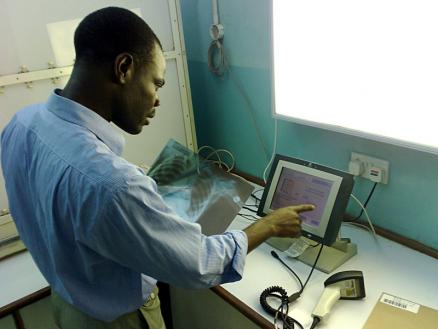 Rashid Demonstrates the X-Ray Process: One of the best-loved features of the Baobab system is its use with tracking and reporting on x-rays.
Rashid Demonstrates the X-Ray Process: One of the best-loved features of the Baobab system is its use with tracking and reporting on x-rays.
- Mike's blog
- Comments
- Read more



- 5244 reads
Hello to the Folks Back Home!
Just a very brief video message from me here in Malawi.
- Mike's blog
- Comments
- Read more



- 4259 reads
Week One Round Up
A great amount of work got done thanks to the help of everyone here. Below is the latest prototype. It's printed on paper, but another version is making the rounds that was printed on indestructible HP LaserJet tough paper, a kind of polyester film available in consumer sizes.
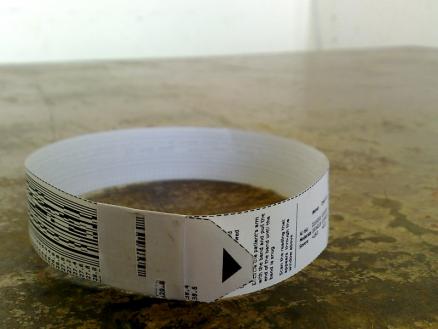 The Latest Prototype
The Latest Prototype
I was also able to get the ART system up and running for the AIDS clinics. Based on the observations we made earlier in the week, I was able to hack into the Ruby on Rails app and get it to work along with the bar-code scanner. Now MUAC data goes straight into the database--a full prototype system, working end to end! Sweet! And it works pretty much as expected (minus bar-code reader) on my touchscreen Nokia internet tablet.
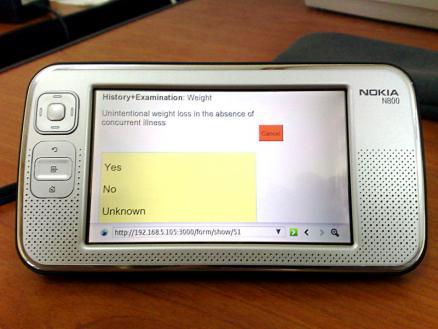 ART application on the Nokia 800
ART application on the Nokia 800
So, next week is testing and observations. That should give me ample time to make adjustments before heading back to the states.
- Mike's blog
- Comments
- Read more



- 6597 reads
Breakthrough
So, I had a good day at the Martin Preuss clinic with the programmers from Baobab. We went for them to interview the stakeholders of the system they've put in place at this combined HIV and outpatient TB center. That was very interesting and gave me some great insights into how the system functions overall.
Then we stopped by the office of one of the nurses, Jane, and Mike McKay helped me out by asking some questions about how Mid-Upper Arm Circumference is tested and why. Some results:
MUAC is measured in the HIV/AIDS clinic on:
- Pregnant Women
- Lactating Women
- Children 1 to 5 years old
The MUAC determines the nutrition status.
For children 1 to 5 the ranges are:
- At risk: 12 to 13.5 cm
- Moderate: 11 to 11.9 cm
- Severe: less than 11 cm
For pregnant or lactating women:
- At risk: 22 to 23 cm
- Moderate: 19 to 21.9 cm
- Severe: less than 19 cm
These patients have their MUAC taken every time they come in.
We then went to the vitals station to see how this was measured. The band used has markings between 7 and 30.5 cm.
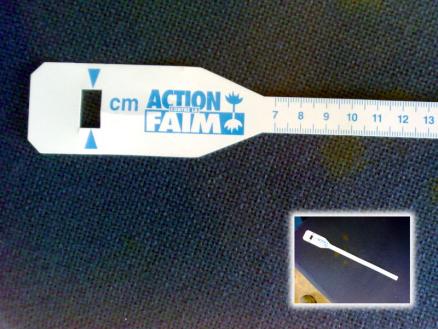 MUAC Strip from Martin Preuss Clinic
MUAC Strip from Martin Preuss Clinic
There is only one of these and it is made of flexible plastic, maybe 5 mil or slightly more in thickness.
At the station, I found:
- A balance scale and stadiometer very much like that in the lab at home (Detecto brand)
- A Baobab touchscreen terminal
- A bar-code scanner
- The MUAC strip
- Detergent dish soap
- Bleach
- Cotton swabs
This leads me to three tentative assumptions:
- The strip is permanent and is regularly cleaned and disinfected
- The vitals station consists of most of what I wanted to include in the system already--the bar-code scanner is already there with the terminal!
- I missed the memo on the length of the band, but it can be changed without much hardship
I am going to try and sit in on a clinician taking these measurements over the next few days and actually watch the station at work. If I can get good observations of the movements and timings involved, I could use that data as a baseline to judge the new work.
I guess you could say today was a good day.
- Mike's blog
- Comments
- Read more



- 4599 reads
MUAC Strip from Martin Preuss Clinic
- Comments



- 12992 reads
Back in Malawi
I'm back in the warm heart of Africa as of two days ago. After recovering from the trip yesterday (which was a national holiday, too) I'm in the Baobab offices fooling with some of the newer ScanBand prototypes.
Since I'll only have Wi-Fi part of the time, my main blogging channel will again be twitter, the feed for which will shown at the top of the homepage until I get back.
Pretty interesting stuff going down here right now. Just an hour or two before I landed, Malawi dropped ties with Taiwan in favor of China. In the long run, it looks like the best financial situation for Malawi, which could receive $6 billion in aid (as opposed to a relatively much smaller amount from Taiwan). In the near term, though, the Taiwanese are pulling out fast, and that could leave clinics run by them in serious disarray until everything stabilizes. This will be a very difficult situation in the next weeks and months for the health-care sector.
Anyway, I'm staying as a guest in an awesome house here. My roommate is William Kamkwamba, known widely for his homemade windmill. He just got back from the US, too, and started school this morning. Wish him good luck!
That's the scoop for now. It's going to be a very busy 10 days, but I'm very glad and very grateful to be back here.
- Mike's blog
- Comments



- 4688 reads
Demonstrating the ScanBand
Tracy generously volunteered to be my patient for the demonstration of the ScanBand arm and waist prototype during my thesis presentation for the end of this semester:
- Mike's blog
- Comments



- 4252 reads
ScaleBand Version Zero
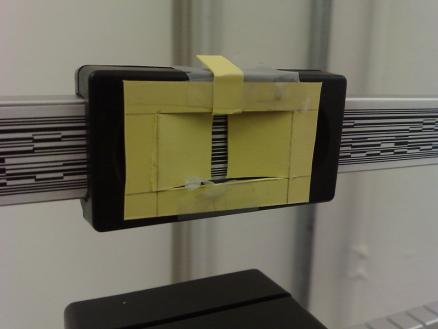 Fine Weight Adjustment with ScaleBand
Fine Weight Adjustment with ScaleBand
For my next trick, I'm modifying a SECA 800 medical scale with a SECA 220 height bar attachment. The measuring surfaces of the scale and bar will be covered or pegged to a scannable strip that represents the specific axis of measurement. I am going to encode the data of the fine and gross weight adjustments, as well as the height bar, so that the measurements coming off of the bar are unique. That way, the receiving system will not confuse a measurement taken from the fine weight measure with a gross weight or height measure.
- Mike's blog
- Comments
- Read more



- 5574 reads
tags
Copyright Mike Edwards 2006-2009. All content available under the Creative Commons Attribution ShareAlike license, unless otherwise noted.

